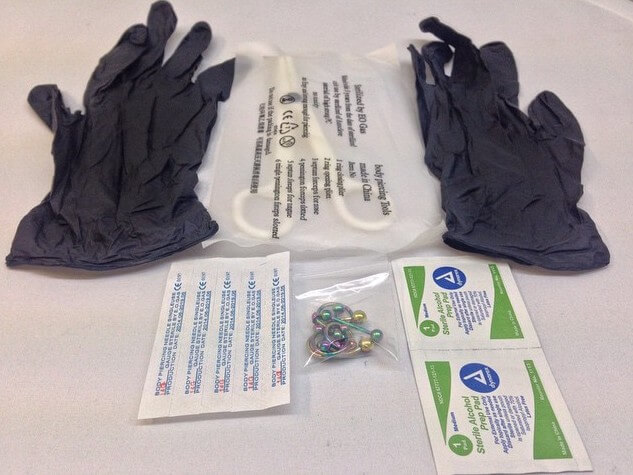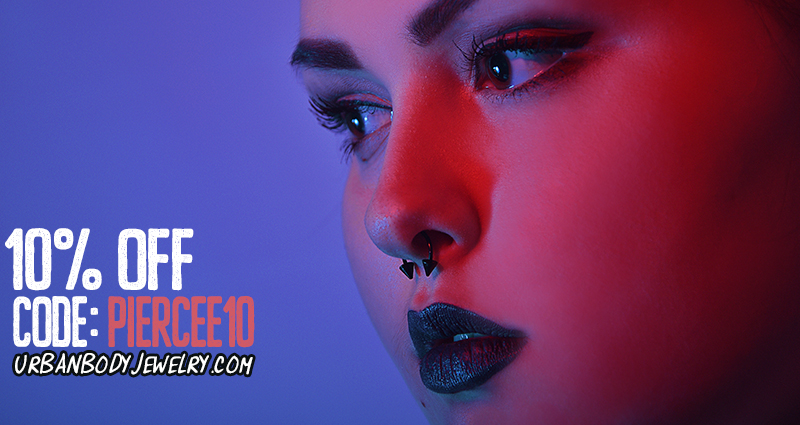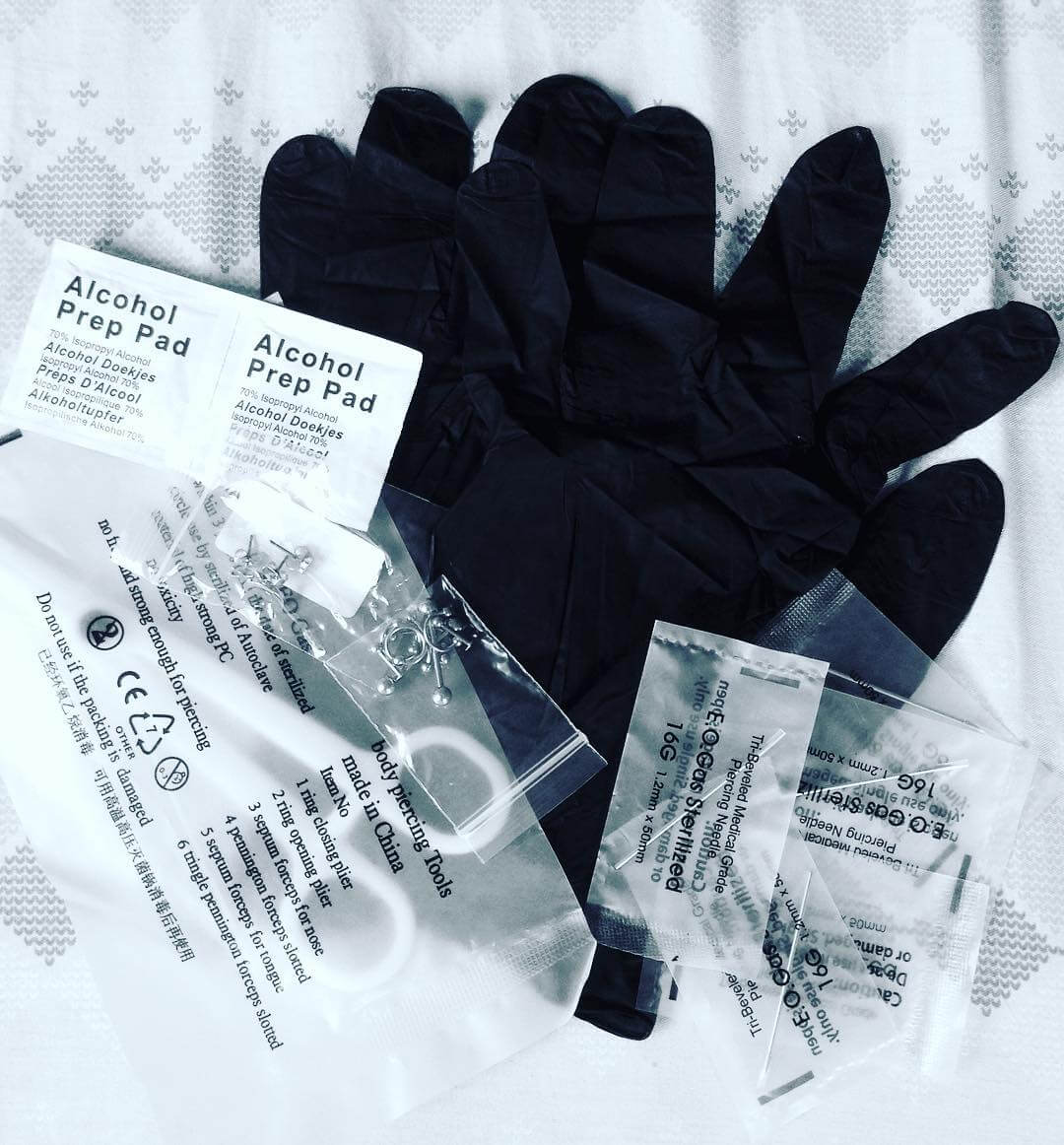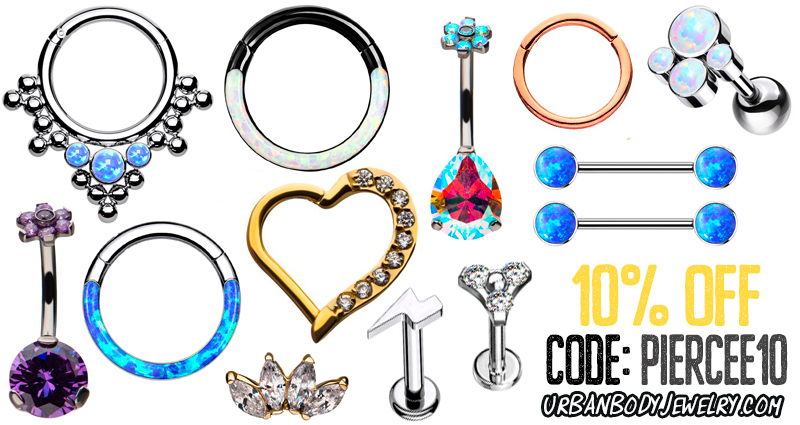
Are you considering piercing yourself? Do you have concerns about getting pierced during the pandemic? These concerns are perfectly valid and should be taken seriously. Infection and unwanted piercings can be urgent issues, and it’s worth figuring out if piercing yourself is worth it beforehand.

While there are many kits like these on Amazon and elsewhere, using them can present their own problems. Sometimes you won’t know certain vital information that a professional piercer would know about specific piercings. This lack of knowledge can lead to infections and piercing bumps if there is cross-contamination or the procedure is not done correctly.
Even if you decide to pierce yourself at home, DO NOT attempt to pierce yourself with a piercing gun. Piercing guns can shatter cartilage on impact and leave earlobe holes incredibly small since they pierce the ears with existing jewelry.

This DIY kit has many of the necessary tools for piercing. 11 styles are available.
Ear & Nose Piercing Reference Videos
Essential Piercing Kit

These piercing kits are the bare minimum for keeping yourself safe if you decide to go ahead with piercing yourself. Most of them contain some combination of the following:
- Sterile piercing needle. Do not ever share needles with anybody.
- Suitable jewelry. Small studs work well so that your piercing heals faster with no movement from a hoop.
- Surgical marker to mark the precise piercing location.
- Ear care solution or saline solution. You will need saline for aftercare to keep your piercing clean.
- Gloves and alcohol wipes to keep the area sterile and clean while piercing.
However, going to a reputable piercer means you are paying for the procedure as well as piercing advice and expertise. Seeing a professional is always recommended over piercing yourself at home.

Getting Pierced During COVID-19 Restrictions
You might be worried about getting pierced right now, and with reason. It’s important to remember that professional piercers always have your health and safety in mind to provide peace of mind for both parties. Piercing yourself at home and risking your health is the last thing you need, and seeking out a professional will ensure that’s not a problem. Here’s a handy walkthrough for how to prepare for getting pierced during the pandemic:

- Decide which area(s) you’re thinking of getting pierced and read up on what’s involved in piercing aftercare. If you’re not willing to commit up to two months to healing your piercing, take some more time to consider if this piercing is for you.
- Find a reputable piercing shop in your area that you feel comfortable going to.
- Call the shop and ask what their pandemic safety precautions are. Most likely, masks will be required before and after the procedure. In the unlikely event that there are no precautions, seek out a different piercing shop that will prioritize your health.
- Ask the shop if they take walk-ins or if you need to make an appointment. Many shops are appointment-only to decrease the amount of people around.
- Show up at your appointment time and be conscious of how to keep yourself safe. Wear your mask until you are instructed to take it off for an oral or nasal piercing.
- The piercer will go over the specifics with you when you show up: which piercing you’re getting, what size and type of jewelry you want, and how the procedure will be conducted. Make sure you feel comfortable and informed about the process before proceeding.
- Be patient while your piercer gets ready. A sterile environment is important for a healthy piercing, and this attention to detail is why you sought out a piercer.
- Sit as still as possible when your piercer is lining up your piercing. Fidgeting or moving around can cause complications. Take a deep breath and stay calm. Follow any advice or instructions your piercer gives you.
- Phew! That pain wasn’t too bad. Stay still while your piercer switches out the needle for your chosen jewelry.
- Your piercer will most likely give you a pamphlet of information on how to care for your healing piercing. Don’t be shy about asking any aftercare questions – piercers would rather answer them now!
- Make sure to grab a business card before you leave. If you have any other questions or encounter a piercing problem, they should be the first ones you call for more information on what to do.
- Start your aftercare procedure when you go to bed that night, and continue it for the appropriate amount of time. A healthy piercing is a happy piercing!
Cartilage Piercing References
At home
By professional
Nose Piercing References
At home
By professional
Eyebrow Piercing References
At home

By professional
Navel Piercing References
At home
By professional
Piercing Aftercare
Proper aftercare is the most important part of getting pierced. Caring for your piercing ensures that it stays as safe as possible. Following these guidelines are a safe bet no matter where your piercing is located:
- Wash your hands thoroughly with soap and water before cleaning your piercing.
- Make sure to clean the piercing twice a day. Saline solution, whether homemade or store-bought, is the best piercing cleaner because of how gentle it is. Apply some saline solution to a clean pad or towel. Hold it on the piercing if there are any crusted debris. Clean both sides of the piercing while making sure you don’t move the jewelry around. Avoid spinning or playing with the jewelry so more bacteria is not introduced into your piercing.
- Avoid jostling the jewelry with clothes or pillows, as a fresh piercing could get infected or bleed from being irritated.
- If you feel that something has gone wrong or you have concerns for your health, contact your doctor immediately. Take these issues seriously and do not try to self-diagnose.
Recommended aftercare solutions:

Sea salt

Aftercare sea salt spray

Swabs


Dos & Don’ts
Do:
- Do your research first. While piercing at home isn’t always unsafe, it does come with far more risks than seeing a professional. These concerns should be considered before making any decisions.
- Do stick to high-quality metals like titanium, gold or surgical steel for your initial jewelry. Quality jewelry will minimize the likelihood of healing issues.
- Do breathe out when the needle pierces your skin to distract yourself and reduce pain.
- If you decide to pierce yourself at home, do make sure you have everything you need beforehand. This will ensure there are less healing issues as a result.
Don’t:
- Don’t use alcohol to clean your piercing. Alcohol only irritates piercings. Stick to saline solution for your cleaning needs.
- Don’t use numbing agents or ice packs as these can cause problems later.
- Don’t play with the jewelry during the healing process to avoid introducing new bacteria to your healing piercing.
- Swelling, bleeding and pain are all signs of piercing problems. Don’t hesitate to be proactive about an infected piercing. Contact your piercer or doctor immediately if you experience one or more of these issues.
FAQs
- Can I use a sewing needle for a DIY piercing?
Sewing needles are not recommended for piercing anywhere, since they are not designed to go through skin.
- Is it okay to use a piercing gun?
Using a piercing gun is not recommended under any circumstances. Piercing guns can shatter cartilage and cause issues with ear piercings even if they are used in the correct way.
- What types of piercings are safest to do myself?
It’s not recommended to pierce yourself at all. However, the combination of less nerve endings, fast healing and lower infection risk makes the earlobes the safest places to self-pierce.
- How do I prevent piercing infection?
Make sure all of the piercing tools you use are properly sterilized and the piercing area is disinfected before doing anything. After the procedure, avoid touching your piercing with dirty hands. Most importantly, do not forget to clean the piercing at least twice a day with saline solution to eliminate bacteria.

Christina Andrusenko
It pisses me off when I can’t find proven information about piercing type I interested in. That is why Piercee was created.
![]()
How to Clean Your Piercings
Ten articles before and after
The Top 5 Trending Piercings of 2021
5 Best Piercings to Wear with a Mask
Best Dainty Cartilage Piercings for 2022
Can I swim after getting a piercing?
Getting re-pierced? Here’s what to consider
Conch Piercing [50 Ideas]: Pain Level, Healing Time, Cost, Experience
Smiley Piercing [50 Ideas]: Pain Level, Healing Time, Cost, Experience
Helix Piercing [50 Ideas]: Pain Level, Healing Time, Cost, Experience
Daith Piercing [50 Ideas]: Pain Level, Healing Time, Cost, Experience
Tragus Piercing [20+ Ideas]: Pain Level, Healing, Cost, Experience